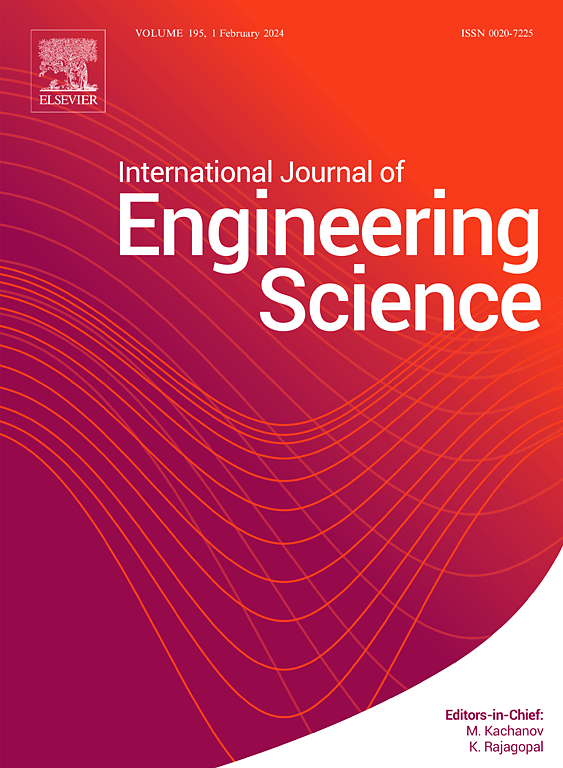具有膨胀-剪切和剪切-剪切耦合能力的二维手性超材料拓扑优化
IF 5.7
1区 工程技术
Q1 ENGINEERING, MULTIDISCIPLINARY
International Journal of Engineering Science
Pub Date : 2025-09-04
DOI:10.1016/j.ijengsci.2025.104367
引用次数: 0
摘要
具有手性微结构的超材料在各种变形模式之间表现出独特的力学耦合。设计此类材料的传统方法严重依赖于具有预定义架构的离散模型和单元格,因此开发能够探索广泛的手性配置并优化机械耦合行为的方法一直具有挑战性,而不受特定单元格几何形状的限制。在本研究中,提出了一种新的多目标拓扑优化(TO)方法,用于设计具有规定的膨胀和两种不同剪切变形模式之间的力学耦合的二维手性超材料。新方法将材料对称约束(包括C2和C4对称)纳入到TO工艺中。采用基于应变能的均匀化方法确定了各周期手性超材料的有效弹性刚度矩阵。TO过程首先最大化刚度矩阵的轨迹,以避免体积模量或剪切模量消失的情况,然后最大化/最小化选定的非对角线分量,以优化膨胀-剪切或剪切-剪切耦合。该方法成功地识别出符合材料对称约束的手性布局的最优拓扑结构,并最大限度地提高了膨胀和剪切变形模式之间的力学耦合。这种新开发的方法可以探索不同的手性材料结构,实现优化的机械耦合,而不依赖于特定的单元胞结构。本文章由计算机程序翻译,如有差异,请以英文原文为准。
Topology optimization of 2D chiral metamaterials with dilatation-shear and shear-shear coupling capabilities
Metamaterials with chiral microstructures exhibit unique mechanical coupling among various deformation modes. Traditional approaches for designing such materials rely heavily on discrete models and unit cells with predefined architectures, and hence it has been challenging to develop methodologies that can explore a broad range of chiral configurations and optimize the mechanical coupling behavior without being constrained by specific unit cell geometries. In the current study, a new multi-objective topology optimization (TO) method is developed for designing 2D chiral metamaterials with prescribed mechanical coupling among dilatation and two distinct shear deformation modes. The new method incorporates material symmetry constraints (including the and symmetries) into the TO process. A strain energy-based homogenization approach is adopted to determine the effective elastic stiffness matrix for each periodic chiral metamaterial. The TO process begins with maximizing the trace of the stiffness matrix to avoid cases with vanishing bulk or shear moduli, which is followed by maximizing/minimizing a selected off-diagonal component to optimize the dilatation-shear or shear-shear coupling. The proposed method successfully identifies optimal topologies that exhibit chiral layouts consistent with the imposed material symmetry constraints, and it maximizes mechanical coupling among dilatation and shear deformation modes. This newly developed method enables the exploration of diverse chiral material configurations, achieving optimized mechanical coupling without relying on a specific unit cell architecture.
求助全文
通过发布文献求助,成功后即可免费获取论文全文。
去求助
来源期刊

International Journal of Engineering Science
工程技术-工程:综合
CiteScore
11.80
自引率
16.70%
发文量
86
审稿时长
45 days
期刊介绍:
The International Journal of Engineering Science is not limited to a specific aspect of science and engineering but is instead devoted to a wide range of subfields in the engineering sciences. While it encourages a broad spectrum of contribution in the engineering sciences, its core interest lies in issues concerning material modeling and response. Articles of interdisciplinary nature are particularly welcome.
The primary goal of the new editors is to maintain high quality of publications. There will be a commitment to expediting the time taken for the publication of the papers. The articles that are sent for reviews will have names of the authors deleted with a view towards enhancing the objectivity and fairness of the review process.
Articles that are devoted to the purely mathematical aspects without a discussion of the physical implications of the results or the consideration of specific examples are discouraged. Articles concerning material science should not be limited merely to a description and recording of observations but should contain theoretical or quantitative discussion of the results.
 求助内容:
求助内容: 应助结果提醒方式:
应助结果提醒方式:


